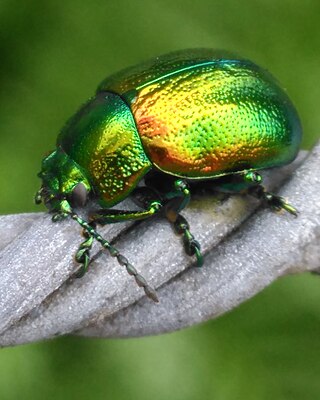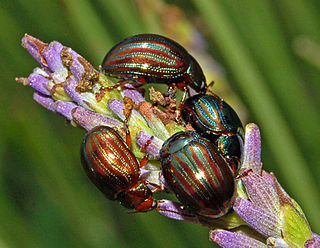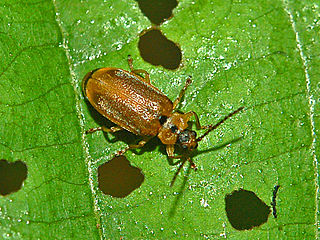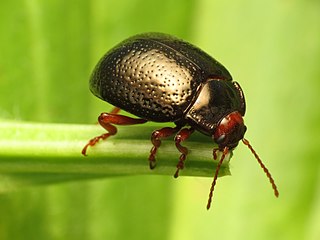
The insects of the beetle family Chrysomelidae are commonly known as leaf beetles, and include over 37,000 species in more than 2,500 genera, making up one of the largest and most commonly encountered of all beetle families. Numerous subfamilies are recognized, but the precise taxonomy and systematics are likely to change with ongoing research.

The tansy beetle is a species of leaf beetle. The common name derives from its main foodplant, Tansy, but it can also use other wetland plants such as Gypsywort and Water Mint. It measures 7.7–10.5 mm in length and has a characteristic bright metallic green colouration, with pitted elytra and a coppery tinge. In addition to the nominotypical subspecies, which repeats the specific name, C. graminis graminis, there are five further distinct subspecies of Tansy beetle, which, collectively, have a Palearctic distribution, although in the majority of countries where it is found the species is declining. In the United Kingdom it is designated as 'Nationally Rare'. The stronghold population here is located along the banks of the river Ouse in York, North Yorkshire. Other, small, fenland populations exist at Woodwalton Fen and at Welney Wildfowl and Wetlands Trust (WWT) reserve.

The scarlet lily beetle, red lily beetle, or lily leaf beetle, is a leaf beetle that eats the leaves, stem, buds, and flowers, of lilies, fritillaries and other members of the family Liliaceae. It lays its eggs most often on Lilium and Fritillaria species. In the absence of Lilium and Fritillaria species, there are fewer eggs laid and the survival rate of eggs and larvae is reduced. It is now a pest in most temperate climates where lilies are cultivated.

The flea beetle is a small, jumping beetle of the leaf beetle family (Chrysomelidae), that makes up the tribe Alticini which is part of the subfamily Galerucinae. Historically the flea beetles were classified as their own subfamily.

The Chrysomelinae are a subfamily of leaf beetles (Chrysomelidae), commonly known as broad-bodied leaf beetles or broad-shouldered leaf beetles. It includes some 3,000 species around the world.

Chrysolina cerealis, the rainbow leaf beetle or Snowdon beetle, is a beetle belonging to the family Chrysomelidae.

Pyrrhalta viburni is a species of leaf beetle native to Europe and Asia, commonly known as the viburnum leaf beetle. It was first detected in North America in 1947 in Ontario, Canada. However, specimens had been collected in Annapolis Royal, Nova Scotia in 1924. In 1996 it was discovered in a park in New York, where native plantings of arrowwood were found to be heavily damaged by larval feeding. The UK-based Royal Horticultural Society stated that its members reported Pyrrhalta viburni as the "number one pest species" in 2010.

Chrysolina americana, common name rosemary beetle, is a species of beetle belonging to the family Chrysomelidae.

Chrysolina is a large genus of leaf beetles in the subfamily Chrysomelinae. Most species are distributed in Europe, Asia and Africa with a small number of species inhabiting North America and introduced species in Australia.

Agelastica alni, the alder leaf beetle, is a species of leaf beetle (Chrysomelidae) in the genus Agelastica. Agelastica alni is distributed in Europe, the Caucasus, Siberia, north-eastern Kazakhstan, and in the 19th century was introduced to the United States.

Chrysomela populi is a species of broad-shouldered leaf beetle belonging to the family Chrysomelidae, subfamily Chrysomelinae.

Gonioctena fornicata is a species of broad-shouldered leaf beetles belonging to the family Chrysomelidae, subfamily Chrysomelinae.

Lilioceris merdigera is a species of beetle belonging to the family Chrysomelidae, subfamily Criocerinae.

Chrysolina fastuosa, also known as the dead-nettle leaf beetle, is a species of beetle from a family of Chrysomelidae found in Europe, Caucasus and northern Turkey.

Cerotoma trifurcata is a species of beetle in the Chrysomelidae family that can be found in the Eastern and West United States.

Galerucella is a genus of leaf beetles in the family Chrysomelidae described by George Robert Crotch in 1873. It is widely distributed but absent in the Neotropics. Some species feed on waterlilies and are used as biocontrol of introduced, invasive waterlilies. Galerucella tenella feed on strawberry plants.

Chrysolina coerulans, also known as the blue mint beetle or blue mint leaf beetle, is a species of beetle in the family Chrysomelidae. It is a member of the subgenus Synerga of the genus Chrysolina. It is native to a wide range of countries between mid and eastern Europe and lives alongside rivers and in meadows, it feeds on various plant members of the mint family.

Chrysolina bankii is a species of leaf beetle native to western Europe and the western Mediterranean Basin. It has also been introduced to the US, where its range is expanding.

Phratora polaris is a species of leaf beetle found in the Nordic regions of Europe., occasionally in Scotland, and Iceland. Some authors have recorded it in central Europe, especially in the Alps. Historically, this species has occurred in Greenland. This beetle is found on willow (Salix) species in the southern part of its range. Populations in Lapland feed on birch.




















